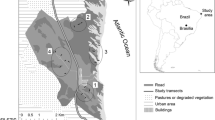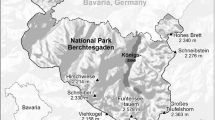Summary
The paper reports on the relationships between vegetation and climate in the Upper Catchment area of Narmada river in Central India. The study site was divided into four ecoclimatic zones based on the classification of Thornthwaite & Mather (1955). While no clear-cut relationships could be established for the subordinate species and climate, the leading dominant species showed interesting relationships. Zones A, B and C show a humid type and support forest dominated byTectona grandis, Dendrocalamus strictus andTerminalia alata. In contrast,Tectona grandis is totally absent in Zone D which falls in a dry sub-humid type.Dendrocalamus strictus forms a second storey species at all places whereTectona grandis is the leading dominant, because the former is not a shade tolerant plant. Growth of the dominant species vary from zone to zone with changes in precipitation, potential evapotranspiration, soil moisture surplus and altitude. With topographical changes the growth of the dominant species changes.Tectona grandis shows maximum growth values on tops of hills only because of their inaccessibility to man so that no disturbances due to illicit felling, shifting cultivation and a host of other disturbances occur. The exiting forest crop is the remnant natural wealth which is the net result of interactions between climate, soil conditions and anthropogenic pressure.
Similar content being viewed by others
References
BransonF.A., R.F.Miller & I.S.McQueen. 1970. Plant communities and associated soil and water factors on shale derived soils in north-eastern Montana. Ecol. 51: 391–407.
LindseyA.A. & J.A.Sawyer, 1971. Vegetation-climate relationships in the eastern United States. Proc. Indiana Acad. Sci. 80: 210–214.
Murthy, M. S. 1967. Ecology of River Narmada Upper Catchment Area. II. Survey of the forest vegetation from Manot to Jabalpur. Ph.D. Thesis. Gujarat University, Ahmedabad, India.
MurthyM.S. 1971a. Eco-climatology of River Narmada Upper Catchment Area. Sci. and Culture 37: 212–213.
MurthyM.S. 1971b. Ecology of Upper Catchment Area of River Narmada. Climo-vegetational relationships-I. Jap. J. Ecol. 21: 188–192.
PandeyaS.C., S.M.Pandeya, M.S.Murthy & K.Kuruvilla. 1967. Forest Ecosystem-Classification of forest vegetation with reference to forests in the River Narmada Catchment Area. J. Ind. Bot. Soc. 46: 412–427.
Pandeya, S.C. & K. Kuruvilla. 1968. Natural forest communities, their net bole biomass and status of their underlying biogenic salts in Dangs forests, Gujarat. Proc. Symp. Recent Adv. Trop. Ecol. Varanasi (R. Misra & B. Gopal, eds.).
RaizadaM.B. 1958. Name changes in common Indian plants. Indian Forester 84: 467–538.
Rao, C.C. 1967. Phytosociological studies on a piece of watershed in the vicinity of rivers, Karamnasa and Chandraprabha (Varanasi Dt.), Ph.D. Thesis, Banaras Hindu University, Varanasi, India.
SubrahmanyamA.R. 1964. Climate and natural vegetation of Mysore state. J. Ind. Soc. Soil Sci. India 12: 101–112.
SubrahmanyamV.P. 1956. Climatic types of India according to the rational classification Thornthwaite. Ind. J. Met. Geophysics 7: 76–82.
SubrahmanyamV.P. 1958. The role of water balance in climatic research. Bull. Nat. Inst. Sci. India 11: 101–104.
SubrahmanyamV.P. 1969. Nature and classification of tropical climates with special reference to India. Indian Forester 95: 659–669.
Subrahmanyam, V.P. & P.S.N. Murthy. 1968. Eco-climatology of the tropics with special reference to India. Proc. Symp. Recent Adv. Trop. Ecol. Varanasi (R. Misra & B. Gopal, eds.), pp. 67–86.
SubrahmanyamV.P. & C.V.S.Sastry. 1969. Some aspects of drought climatology of the dry sub-humid zones of South India. J. Met. Soc. Japan 47: 239–244.
SubrahmanyamV.P. & C.V.S.Sastry. 1969. Climatic analogues for the dry regions of India. Trop. Ecol. 10: 34–44.
ThornthwaiteC.W. & J.R.Mather. 1955. The water balance. Publ. in Climatology. Drexel Inst. Tech. 8: 1.
WhittakerR.H. 1965. Dominance and diversity in land plant communities. Science 147: 250–260.
WhittakerR.H. 1969. Evolution of diversity in plant communities. Brookhaven Symp. Biol. 22: 178–196.
WhittakerR.H. 1970. The population structure of vegetation. In: R.Tüxen (ed.), Gesellschaftsmorphologic. Ber. Symp. Int. Ver. Vegetationskunde, Rinteln, 1966. Junk, The Hague, pp. 39–59.
Author information
Authors and Affiliations
Additional information
Nomenclature follows Raizada (1958).
The author gratefully acknowledges the painstaking training in the computation of water balances given to him by Professor V. P. Subrahmanyam and Dr. B. Subba Rao of the Department of Climatology, Andhra University, Waltair (India). Most of the work presented here is the result of prolonged and consistent discussions with my teacher, Professor S. C. Pandeya, Head of the Department of BioSciences, Saurashtra University, Rajkot, India, for which I am indebted. Financial assistance was provided by the Council of Scientific and Industrial Research, Government of India, in the form of a Senior Fellowship.
Rights and permissions
About this article
Cite this article
Murthy, M.S. Relationships between vegetation and climate in the Upper Catchment area of the Narmada river, Central India. Vegetatio 36, 53–60 (1978). https://doi.org/10.1007/BF01324771
Accepted:
Issue Date:
DOI: https://doi.org/10.1007/BF01324771




